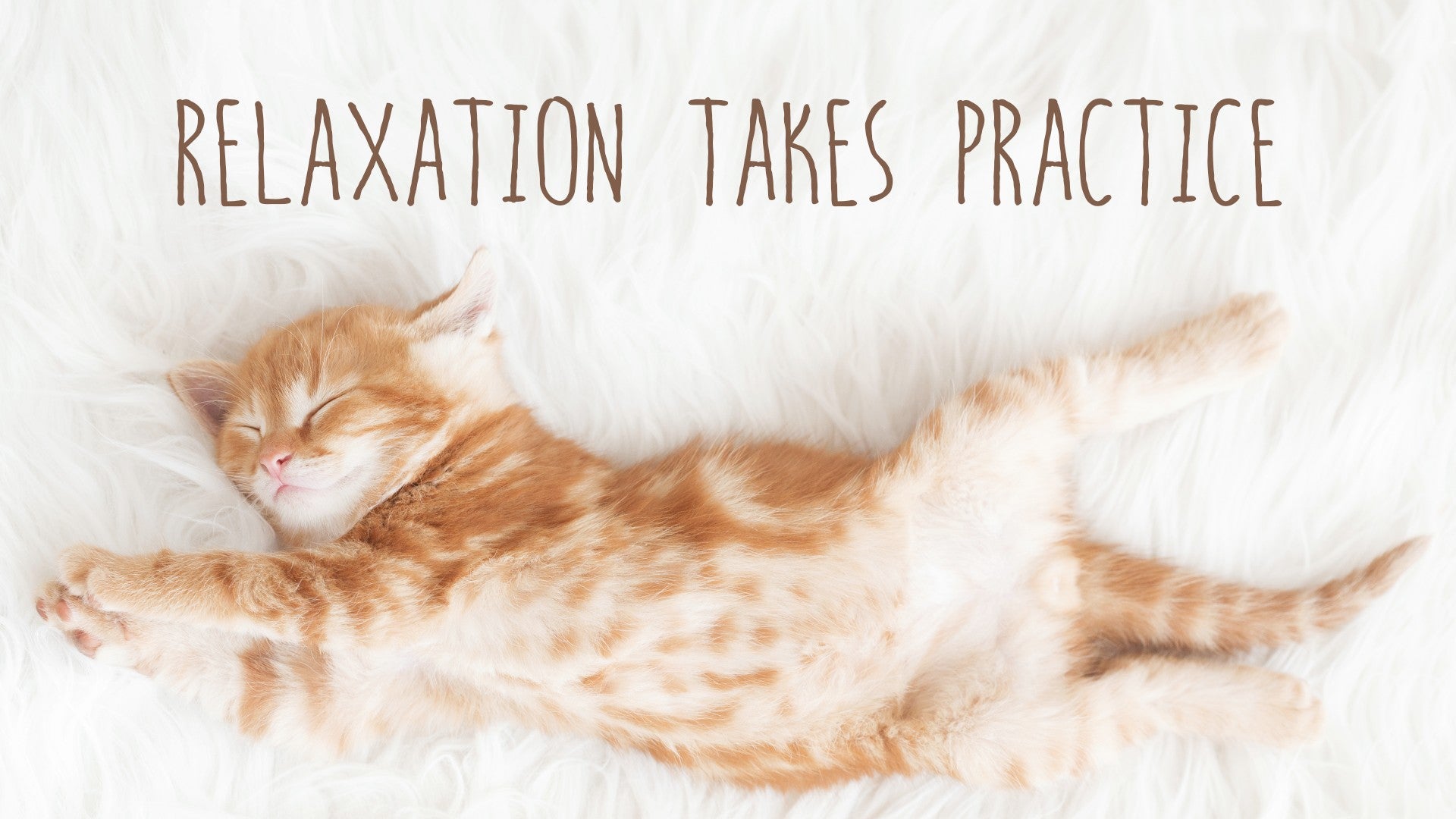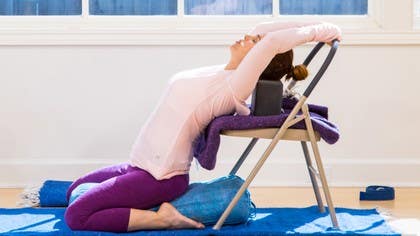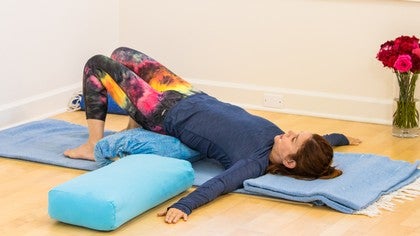Description
About This Video
Transcript
Read Full Transcript
(waves splashing) Hi everyone, namaste. Thank you for joining me here today. Today's lesson is Restorative Yoga on the Chair. The chair is my favorite, all-time yoga prop. Um, it's a very unique prop to use because of its height.
It can address flexibility issues but it can also really open up areas of the body that may be difficult for you to get into on you own. So, the poses are pretty simple. What you'll need is a chair. Any chair will do, it just has to have a place for your legs to go through. You need one yoga belt.
You'll need three yoga blankets, one for the floor covered over you mat, and the others will fold for other yoga positions. And then one bolster and one block, and that's it. Let's get started. The first one is a seat for mindfulness. It's really just an opportunity for us to be upright in our spine, to sit and breathe and plug into our breath.
It's done like this. Here's your yoga belt. I'm gonna stand up, just so you can see what we're gonna do. I'll unfold the belt and I wanna measure it right away, so that the two tails are very even, and there isn't really any twist in the belt. Then I'm gonna place the belt right around my neck, and then I'm gonna bring it behind my armpits.
I'm gonna turn around so that you can see I'm crisscrossing them behind me, and I'm just kind of trying to feel my way into the fact that there aren't any wrinkles in the belt. Then we'll bring it around the front. I'm sitting down on the seat of the chair again toward the front edge of it. You can bring your legs out in front of you comfortable, hip width distance apart or a little wider, if you choose. And now I've got the two tails of the belt, and I'm gonna bring them underneath my legs and fasten them.
If you're using a D-Ring, it goes through the two rings, and then you separate the rings and pull up on it. And I'm gonna pull just until I feel a little snug and it opened my chest a bit. The belt will slide a little towards your back thighs, and that's totally fine. Feels good (chuckles). So now I'm just gonna place my hands on the top of my thighs.
The belt feels so nice it lifts my chest up, it aligns my head on the top of my spine. I'm gonna close the eyes, so go ahead and close yours with me. (inhales) Take a big breath and just set aside everything that's come before this. You can attend to these things at a later time. Just notice that your inhales and exhales are happening.
And with the least amount of effort on your part, see if you can smooth them out a little bit. And then just because we're doing this variation with a belt, with each exhalation, see if you can let your shoulders just release down away from the neck and ears a little more. The belt should make you feel as though you're getting a little bit of traction there. (deep breathing) Sense the steadiness in the lower body. And if you could just let your shoulders go a little bit more, and release the weight of the hips a little bit more.
And listen to the breath you're taking right now, and follow five more concentrated breaths. When you finish with that fifth breath, just gently open the eyes, and when you open them, let the outer edges of the eyes relax like you're taking the landscape in rather that trying to reach out for it. Okay, so we'll remove the belt. It's pretty easy to do. I'm just gonna lean forward, slide the belt back a little bit to get a little bit of slack in it, and then I can unfasten it from here.
Once I get it unfastened, I'm gonna let the heavy edge just fall, and then go ahead and stand up, and slide the belt to the front, and then go ahead and remove it altogether. So, we're not going to need the belt for the rest of the practice, so let's go ahead and roll it up. And then we'll push it to the side. And then we'll go ahead and do the next pose which is Pavrivrtta Janu Sirsasana. It is Revolved Head-to-Knee Pose.
I'm gonna take the chair, um, and as you can see I've put a blanket folded on top of it. And that's just to give my head a little bit of padding. I'm gonna grab the other blanket. I've already folded it, but basically once you've folded it into the 1/4, you're just gonna fold it again, and it's gonna be a little meditation pad. And that's gonna be for you hips, so it's your little seat.
I'm gonna go ahead and stretch my left leg all the way through the chair and bring my right leg in a Baddha Konasana, which is a Bound Angle. Now you can bring your leg behind you if you prefer, in a Virasana shape, so just do what seems to feel best for you. This should be placed underneath you so you feel a little bit of elevation. Don't worry about this left leg, it can come close to the chair, it can come to the far edge of the chair, whatever you think you might be able to do. I do want to mention that if you are taller than me, say maybe 5'6', 5'7' and above, you might want to put your chair up a little bit higher, so that you don't have to reach and bend so low to get to it.
So there's already the blanket on the chair. I'm gonna go ahead and fold it, just make it a little bit higher for me. Then on inhalation, reach the right arm all the way up. As you exhale, bend at the left side, and so you can just let that left hand slide down until your head reaches on top of that support. And we're gonna take the top arm, if you wish, hold onto the back ring of the chair, otherwise you can let this right arm just drop all the way down, and rest right on top of the chair.
Whatever feels good. So if you come here, to the closer corner, it's a little less stretch. If you go to the middle, it's a little more. If you go all the way over, it's a lot more. So you can decide what kind of feeling you can be with.
And then I'm just gonna let this other arm just release. Let my head be heavy. Let's be here for about a minute and a half. (breathes deeply) Easy inhales and exhales. And I'm doing the same thing I did before, with the exhalation, I'm letting the weight of the shoulders release, and I'm letting the weight of the pelvis release.
And this left arm can just go where it wants to go. It's loose and limp. It doesn't have to do anything. (deep breathing) You might find that you get a little bit of cracks in your lower back. I'm starting to feel mine go, and it feels great.
(deep breathing) Let the whole weight of the body go. One more time. Can you use that exhale to let those shoulders drop down away from the ears and neck, and the weight of the hips sink down into gravity. Listen to the breath that you're on and go ahead and take one more. Now we're gonna take the bottom hand, the left hand, and press it down to the floor.
When you inhale, reach your top arm, your right arm, all the way up. Push with your left hand, come all the way up to the center. Oh gosh, that feels so good! (sighs) Just pause a moment. And let's get ready for the opposite side. I'm just gonna take the chair and bring it right over to the other side.
And I'm gonna readjust my bottom blanket. Everything is done is slowly in restorative yoga, we don't have to be in a hurry to change the props. It's part of what we're doing. So it's just done mindfully, slowly. Bring the chair in a little bit.
Once you're settled take an inhale. Lift your spine, lift your left arm up. As you exhale, slowly begin to bend at that right waist. Reach for the chair or feel free to just drop that arm, and let it rest on the seat of the chair instead. Then you can decide where you want to put this top arm.
Little easier stretch, little stronger, little more, and then let that head go. Once again, let's take about a minute and a half here. Bottom arm totally out of the picture. And we let those exhalations be an invitation to soften the shoulders, and release the weight of the pelvis into the ground. (sighs) Once again inviting that exhalation to be a moment where the shoulders drop and relax a little more.
And the weight of the pelvis sinks into gravity. And then listen to the breath that you're taking right now and follow it with one more breath. And you'll turn your bottom hand, your right hand down to the floor. And on an inhale, stretch your left arm up, push with the bottom hand, and come all the way up to the top. Now hopefully, you feel pretty equal (chuckles) on both sides of your waist.
Close the eyes, just pause for a moment, and then open the eyes. And we'll set up for the next pose, which is Ustrasana, Camel Pose. And some of you may say, Camel Pose? How can we do that restoratively? Well, you're gonna be excited about that.
I know I am. It's a pose that I love going into. Um, I'm gonna move this chair to the opposite end, just because later on I'm gonna be using it a little differently. I'm gonna put this blanket on top as it was before. I know I just took it off, but I decided I want a little bit more cushion here on the lip of the chair.
And then I'm gonna use the bolster and the block. So I'm bringing those back over to the mat. And it doesn't matter what kind of block you have, you can have a foam block or a cork block or wood one, it doesn't matter. What matters is how much height you need for your head. I'm gonna start at the high end.
I'm placing the bolster right in front, parallel to the mat. I'm gonna straddle the bolster, and I'm gonna come in pretty close to the chair. If you're about 5'7" and above, you may wanna take the chair a little further away from you. But the first thing I do is just hold on to the front legs of the chair, and lift my chest up, 'cause I'm going into a backbend. So I lift the chest, and where I want that lip of the chair is right between the shoulder blades, and then I continue to weight my hips down into the floor, lift my chest, reach for the block, let my head rest on top of it.
Oh, already it feels really, really good (chuckles). And then I'm gonna hold on to the sides of the chair. If you want less sensation, you can hold on a little higher, little further out brings more sensation. All the way out brings the most amount of sensation. And I'm just gonna adjust a little bit with my pelvis.
Let my head, my shoulders, and my pelvis be heavy, just like before. And let's stay here about 2 1/2 minutes. At any given time, you may feel things begin to open up. Maybe you don't need quite as much height underneath your head. So you can just adjust the height of the block whenever that makes sense.
And if you find that the stretch becomes too much for the front of your chest, or the front of your shoulders, you can just release the arms and let them rest down to the tops of the thighs. Just go where it makes sense. Relax the jaw. So we've been focusing a little on shoulders relaxing and the weight of the pelvis dropping, and now the head, as well. Head letting go.
Listen to your breath. Any stress you've accumulated around your throat, unspoken words, shoulders squeezing, let it go. It's also okay to open the mouth with an exhalation. In fact, let's go ahead and do that. Let's listen to the breath that we're on, and then take one more slow inhale.
As we exhale, let a soft sigh come out of the mouth. (sighs) If your arms are behind you, go ahead and release them. Just let them hang down along side the body for right now. And then you're gonna lift with your chest, tuck your chin, push off you fingertips, lift with your chest to come all the way upright. Bring your hands to your thighs, close you eyes and pause (sighs).
And that was great. Okay, so we're gonna lean forward, come off the bolster, and start to set ourselves up for the next, which is Upavistha Konasana, or Wide-Legged Seated Forward Bend. We don't need the bolster for this, so I'm gonna push it out of the way. We don't need the block, so I'm gonna push that out of the way. But we do need, everything else that's in front of you, the chair and also the blanket on top for a little cushion.
Now you can sit on this other blanket if you want a little bit of seat underneath you. I'm just gonna practice it without the, that support today, but feel free, use it if you'd like. I'm gonna slide my legs all the way out to the sides into a 90 to 120 degree angle, doing the best that you can. Bring your chair as close as you think you might need it. What you want is no rounding in the lower back.
So how I normally get into this is when we inhale, we're gonna press down with the hands and lift the spine a little bit, and use this chair as a little bit of leverage to get length. And then exhale, hinging forward, let the forearms bend, or the elbows bend rather, and just rest your head, your forehead right on top of one forearm. Relax the shoulders. Once again, it's pelvis down, shoulders down, head down. And we'll be here for three full minutes (deep breathing).
And if you find that things start to open up a little bit more, you can draw the chair away from you a little to accommodate that stretch. But remember, you're not looking for the greatest stretch. This is the time to just be in the shape of the pose, this is a Wide-Legged Forward Bend, to bring the pose to you, and to practice deliberately relaxing while you're in this shape (breaths deeply). Try to avoid any urges to achieve. Instead exchange that for feeling, breathing, and being.
You can use the next exhalation to weight that pelvis, to let the shoulders melt away from the ears, and release the weight of the head down into the support. Now go ahead and listen to the breath that you're taking right now, and complete one more breath. And then when you're finished on an inhale, just lift the head and the chest, bring the hands to the seat of the chair once again, push through your palms to straighten the arms and sit upright, and exhale, release the arms down. And if you need to bend the knees again, go ahead and do that, otherwise just keep the legs stretched out, close the eyes and pause. Feel the effects of the Seated Forward Bend.
It should be very relaxing to the nervous system, if you've got enough support underneath the head. And then gently open the eyes. If your legs are stretched out to the sides, grab ahold just underneath the knees and slowly draw the legs toward one another, and then go ahead and crisscross your legs once again. And we'll set up for the final pose, which is Savasana. but we're gonna practice it on the seat of the chair.
So it's really, Legs up the Chair in Savasana. I'm gonna turn the chair around, and I'm doing that so that I can have the lip of the chair just slightly elevated from the back end of the chair. So we're all set, the chair is turned around and now we're ready for Savasana (chuckles). So sliding my body toward the seat of the chair, lowering my self down and bringing the backs of the knees to the back lip of the chair. And you wanna come in close enough so that the knees are pretty forward of the pelvis.
Now I just slide all the way down. You have that extra blanket, so if you wanted to put it underneath your head you could. Now I'm just kind of wiggling myself around a little bit until I, until my whole body goes, ahh. There it is. Once I get there, releasing my arms, making sure that my weight is right on the center of the skull.
And now I can drop even a little deeper. Let's drop together for the next seven minutes. Even in your efforts to practice being quiet, you may notice a lot of noise going on in your head. It's okay, it's natural. Just follow it directly back to deliberately relaxing.
Wherever your awareness is, keep coming back to relaxing. Relax a little more. Feel what you feel like, when you're feeling relaxed. Mmm, this last little bit now. See if you can drop just a little deeper.
Let go a little more. And just become aware of the breath passing in and out of the nostrils. Come aware of the solid ground beneath you. Take a longer inhale and a deeper exhale. And just slowly roll your head to the left, like you're moving through water, really slow.
And then return your head back to the center, and then roll slowly to the right. And then return your head back to center. Rub your thumb and index fingers up against one another. And see if you can become aware of your outer surrounding but still sort of stay inside. As you begin to let more movement stir through your body, your wrists and your ankles, eventually your elbows bend, you can let your hands rest somewhere on the torso, the belly, and the chest.
Whatever feels good. Then prepare to bend your legs, so just bend one leg at a time. Draw them in, a little close to towards your chest. Rock side to side on your lower back, if you like that. And then we'll roll over onto the right side in a fetal position.
Once you get there, just pause. And then go ahead and lean your chest into the floor, use your left palm to push, let your head be the last thing that comes up. And find yourself in a comfortable seated position. Close the eyes once again. Bring your hands to your chest.
Thank you for sharing this chair practice with me today. I hope you enjoy it as much as I do, namaste.
Relaxation Takes Practice
Comments
XO, LC
You need to be a subscriber to post a comment.
Please Log In or Create an Account to start your free trial.











